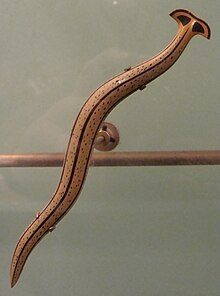Our website is made possible by displaying online advertisements to our visitors.
Please consider supporting us by disabling your ad blocker.
Bipalium
| Bipalium | |
|---|---|

| |
| Model of Bipalium strubelli | |
| Scientific classification | |
| Domain: | Eukaryota |
| Kingdom: | Animalia |
| Phylum: | Platyhelminthes |
| Order: | Tricladida |
| Family: | Geoplanidae |
| Subfamily: | Bipaliinae |
| Genus: | Bipalium Stimpson, 1857[1] |
| Type species | |
| Bipalium fuscatum Stimpson, 1857
| |
| Synonyms | |
Bipalium is a genus of large predatory land planarians. They are often loosely called "hammerhead worms" or "broadhead planarians" because of the distinctive shape of their head region. Land planarians are unique in that they possess a "creeping sole", a highly ciliated region on the ventral epidermis that helps them to creep over the substrate.[2] Native to Asia, several species are invasive to the United States,[3] Canada, and Europe.[4][5] Some studies have begun the investigation of the evolutionary ecology of these invasive planarians.[6]
- ^ Stimpson (1857). "Prodromus descriptionis animalium evertebratorum quæ in Expeditione ad Oceanum, Pacificum Septentrionalem a Republica Federata missa, Johanne Rodgers Duce, observavit er descripsit. Pars I. Turbellaria Dendrocœla". Proceedings of the Academy of Natural Sciences of Philadelphia. 9: 25. JSTOR 4059187.
- ^ Curtis, S.K.; Cowden, R.R.; Moore, J.D.; Robertson, J.L. (1983). "Histochemical and ultrastructural features of the epidermis of land planarian Bipalium adventitium". Journal of Morphology. 175 (2): 171–194. doi:10.1002/jmor.1051750206. PMID 30060639. S2CID 51875789.
- ^ Ogren, R.E. 1985. The human factor in the spread of an exotic land planarian in Pennsylvania. Proc. of the Penn. Acad. of Sci. 59: 117-118.
- ^ Justine, Jean-Lou; Winsor, Leigh; Gey, Delphine; Gros, Pierre; Thévenot, Jessica (2018). "Giant worms chez moi! Hammerhead flatworms (Platyhelminthes, Geoplanidae, Bipalium spp., Diversibipalium spp.) in metropolitan France and overseas French territories". PeerJ. 6: e4672. doi:10.7717/peerj.4672. PMC 5969052. PMID 29844951.

- ^ Filella-Subira, E (1983). ""Nota sobre la presència de la planària terrestre Bipalium kewense Moseley, 1878 a Catalunya"". Butll. Inst. Cat. Hist. Nat. 49: 151.
- ^ Ducey, P. K.; West, L. J.; Shaw, G.; De Lisle, J. (2005). "Reproductive ecology and evolution in the invasive terrestrial planarian Bipalium adventitium across North America". Pedobiologia. 49 (4): 367. doi:10.1016/j.pedobi.2005.04.002.
Previous Page Next Page


